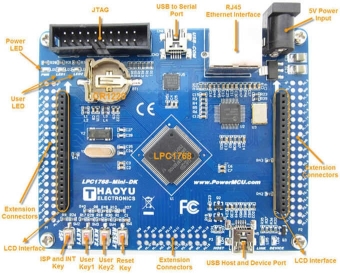Library for Mini-DK board
Dependents: LPC1768_Mini-DK_EasyWeb_DM9161 LPC1768_Mini-DK LPC1768_Mini-DK
Fork of Mini-DK by
Mini-DK board overview (Micro SD connector is at the bottom side)
One serial interface , uses CP2102 (USB to RS232 interface, support ISP download )
RJ45-10/100M Ethernet network interface (Ethernet PHY: DM9161)
2.8 inch TFT color LCD interface (SPI interface or 16Bit parallel interface)
Touch panel controller XPT2046 (ADS7843 compatible)
USB 2.0 interface, USB host and USB Device interface.
TF SD / MMC card (SPI) interface.
Two user buttons, One Reset button and ISP button , One INT0 button, two user-programmable LED lights
Serial ISP download, Standard 20-pin JTAG download simulation debugging interface.
Selection between external 5V power supply or USB 5V supply.
Board size: 95mm * 78mm
All IO available on extension connectors

04/01/13
Erik Olieman (http://mbed.org/users/Sissors/) joined the code development for the Mini-DK board.
Thanks to his input, we were able to obtain a tremendous speed gain, remove warnings, ...
An overview of all modifications is stored in modifs.h
The old page (http://mbed.org/users/frankvnk/code/LPC1768_Mini-DK/) contains the demo code.
IMPORTANT : Due to a change in the mbed libraries (Stream()), we cannot use the printf instruction - we need to use <SPI_TFT>.printf (example - see main.cpp in http://mbed.org/users/frankvnk/code/LPC1768_Mini-DK/)
WARNING: filetoflash (SD to CPU flash)
The SPI_TFT library contains an option to copy an image from the SD card to the CPU flash memory. This allows you to use an image as background without speed loss when writing other text and graphics.
By default, this option is enabled.
It can be disabled by uncommenting the #define mentioned below in Mini_DK.h:
#define NO_FLASH_BUFFER
Since the flash memory has limited write endurance, DO NOT use this feature when you intend to read multiple images from the SD card (eg: when used as a photo frame).
14/01/13
A newer version of the Mini-DK has been released by the manufacturer: Mini-DK2. They replaced the DM9161 PHY with a LAN8720A PHY and better buttons are fitted on the board. All other hardware remains the same. Code for this PHY is available from the NXP MCU SW application team. This allows us to use the mbed 'EthernetInterface' library with little modifications. Further info - see http://mbed.org/forum/mbed/topic/3684/?page=1#comment-18473.
Notes:
The code in 'lpc_phy_lan8720.c' uses 'msDelay' - needs to be replaced with 'osDelay'.
A custom MAC address can be defined using following code:
extern "C" void mbed_mac_address(char * mac) {
// define your own MAC Address
mac[0] = 0x00;
mac[1] = 0x01;
mac[2] = 0x02;
mac[3] = 0x03;
mac[4] = 0x04;
mac[5] = 0x05;
};
modifs.h
- Committer:
- frankvnk
- Date:
- 2013-01-03
- Revision:
- 2:d0acbd263ec7
- Child:
- 3:fb4d62b5ffb3
File content as of revision 2:d0acbd263ec7:
/*
Date : 31.12.12
Author : Erik Olieman
---------------------
Code readability and speed
1. created separate structure for mini-DK (base for library)
2. Removed wr_dat_only routine (uses 8 bit transfer = slow)
Replaced each wr_dat_only with
_spi.format(16,3);
.....
_spi.write(...);
.....
_spi.format(8,3);
3. Creation of Mini-DK.h with all declarations specific to the mini-DK board.
Date : 31.12.12
Author : Frank Vannieuwkerke
----------------------------
NOTE : Current code contains SPI_TFT *LCD; in Touch.h
TouchPanel_Calibrate, TP_DrawPoint and DrawCross in Touch.cpp use LCD->...
These are currently commented out since using them locks up the system although
the compiler does not show any errors. Current code works but the calibration
crosshairs do not show - touching their approximate position still allows you to
calibrate and draw (TP.TP_DrawPoint in main.cpp temporarily replaced with TFT.rect).
??Other solution : see TODOs below??
Possible advantage of this solution :
Touch library fully independent of LCD library.
Perhaps do Calibration with a printed template when LCD is not used (less accurate).
This would only be useful when a touchpanel without LCD is used.
Removed reset pin from SPI_TFT (not needed - pin is connected to main reset).
Separated SPI_TFT from TouchADS7843
In main.cpp
-----------
TODO: before TP.TouchPanel_Calibrate()
cls
draw 3 crosses with numbers according to DisplaySample in touch.cpp
Use following text : Calibration - Touch each crosshair in the numbered sequence.
after TP.TouchPanel_Calibrate()
cls
Moved following global touch var declarations (at top of main.cpp) to touch.cpp/.h
Matrix matrix;
Coordinate display;
Coordinate screen;
NOTE : i did not create a class with var readback, just used plain C notation.
These vars can be accessed from other code through <classname>.<varname>
example : TP.display.x
Only drawback : Each element of these vars needs to be initialised separately.
(initialisation of these vars is not possible with array notation).
In Touch.cpp/.h
---------------
Removed TP_Init - moved TP_init code to constructor.
TODO : Avoid using TFT_LCD library : remove all references to LCD driving
remove Drawpoint and Drawcross
remove #include Arial12x12
Variables in call to TouchPanel_Calibrate, Read_Ads7846, getDisplayPoint are no longer needed.
Modified these routines accordingly in touch.cpp/.h (pointers no longer needed)
*** TouchPanel_Calibrate and getDisplayPoint already modified.
TODO: Problem with Read_Ads7846 -> is also called in TouchPanel_Calibrate (Touch.cpp) with other var.
Solution : in TouchPanel_Calibrate, change screen_cal to screen_tmp and copy (TP.)screen to this
variable. Put screen_tmp back to (TP.)screen after setCalibrationMatrix.
General notes
-------------
lpc1768 SPI port - problem with using SD and TFT simultaneously
see note http://mbed.org/comments/cr/83/2654/#c4768
google search : lpc1768 ssp ssp0 ssp1
perhaps use softspi (eg http://arduino.cc/forum/index.php?topic=117356.0)
Ignore above notes - use Erik Olieman's solution.
*/


